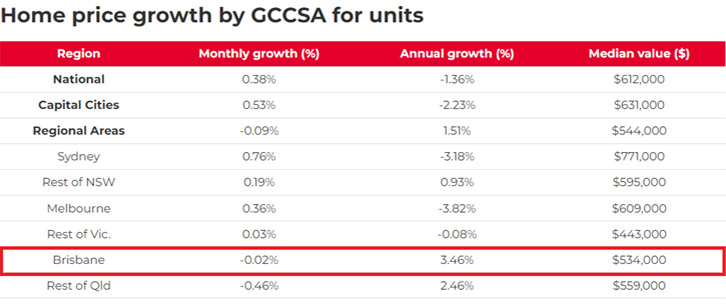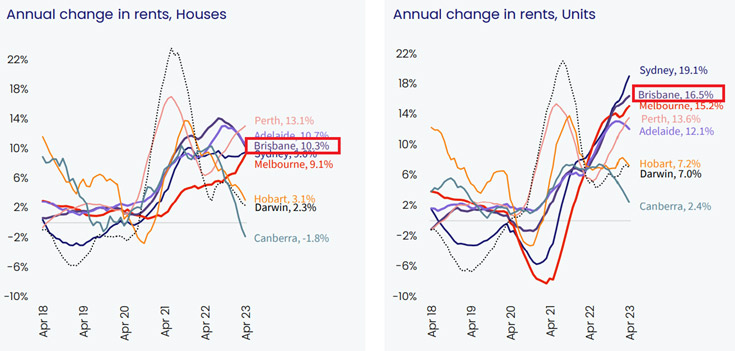Good news for Brisbane property owners: Values rise again for second consecutive month
Brisbane’s increased dwelling values, high rents and low vacancy rates, plus a growing population looks positive for Brisbane property owners, but not so bright for tenants.
Brisbane has finally shown signs of passing the bottom of the market downturn, following a record-breaking streak of month-on-month median value declines.
Since the start of 2023, the rate of price falls has rapidly recovered, with dwelling values experiencing slight increases for two consecutive months across the city.
Despite potential economic headwinds in the coming months, most experts now predict that prices will continue to recover.
Easter and Anzac Day holidays did not seem to alter Brisbane’s market activity while buyer activity on-the-ground remained strong, and the market continued to pick up pace.
New listings tightened further during April compared to the month prior, according to CoreLogic, down 22.5 per cent compared to the same period last year. The volume of sales across Brisbane also declined 22.3 per cent over the last 12 months.
The decrease in sales is proportional to the decline in new listings, indicating that the properties listed for sale are finding buyers in the current market. Total listings were down only slightly by 1.8 per cent compared to the same period last year.
There were 18,162 properties listed for sale in Brisbane during April, however, this number remains over 30 per cent below the monthly average of over 30,000 listings in 2019 and previous years, as reported by SQM Research.
Supply is an ongoing issue, which has no doubt contributed to putting a floor under further property price falls.
The Queensland Government introduced changes in April to the frequency landlords can increase rent on their investment properties. As of July 1, a lessor is not permitted to increase rent on a new lease if it was already increased less than 12 months previous. Rental price increases more frequent than every 12 months are no longer permitted in Queensland.
In a Rental report issued by the RBA, just over 70 per cent of all rental properties have lease agreements of 12-months or more already in place, so this is not likely to impact the majority of investors.
It is, however, another small disincentive for property investors who have been hit with a number of proposed and legislated changes over recent years. It impacts investor sentiment, and the number of investors willing to get into the market. This is especially true when a lot of the changes appear to be retrospective.
Buyers are however out in higher volumes at open homes, auction attendance is strong and bidder registrations remain elevated, and auction clearance rates have increased from a weekly average of 53 per cent across March to 62 per cent in April, according to Domain.
For every property there appears to be more than a single buyer, so demand is definitely outstripping supply. Fundamentally, this is what is putting upward pressure on prices once again.
Dwelling Values in Brisbane April 2023
Brisbane dwelling values, reported by CoreLogic, increased for the second month in a row, with 0.3 per cent growth throughout April. This has also resulted in a turn-around in the quarterly growth for Brisbane dwelling values which is now positive once again.
The median value for a Brisbane dwelling is currently $705,016, which is $6,945 more than last month.
PropTrack data confirmed the same trend with 0.14 per cent dwelling price growth reported throughout April.
The price segmentation data for all dwellings from CoreLogic up to the end of March 2023, still shows that properties in the bottom 25 per cent of values are outperforming higher value properties.
In the first quarter of 2023 the lowest 25 per cent of property values that sold, showed a decline in values of 0.6 per cent in Brisbane.
Alternatively, the top 25 per cent of properties that sold showed a median value price decline of 2.1 per cent.
One explanation for this, is that units are typically filtered in the lower value price segment. We know that the unit market has been outperforming the housing market in Brisbane over the last 12+ months. There may also be some compositional bias based on what has been selling, with lower listing and sales volumes, and therefore a smaller volume of transactions would have contributed to this data.
Brisbane House Prices April 2023
House values continue to recover in Brisbane according to CoreLogic. With a further 0.2 per cent change in the median value throughout April, it is evident that prices have stabilised. Quarterly, house prices are still slightly down 0.1 per cent.
The median value for a house in Greater Brisbane is now $781,881, which is $9,861 more than last month. PropTrack data also confirms this trend with 0.17 per cent growth in house values for April reported.

Source: CoreLogic.
Brisbane Unit Values April 2023
Unit price growth in Brisbane continues to outperform house price growth across the city. In April, CoreLogic data showed 0.9per cent unit price growth, with quarterly data now demonstrating a 1.1 per cent increase in values.
The median value for a unit across Greater Brisbane is $498,374 which is $5,959 more than last month.
Whilst CoreLogic data is reporting that unit values have outperformed house values throughout April, PropTrack data shows a different trend where units have retracted ever so slightly by 0.02per cent.

Source: PropTrack.
Rental Market in Brisbane April 2023
There has been little change in the rental market across Brisbane throughout April. Vacancy rates remain well below 1 per cent across the city, an indication that supply is limited for most property types.
The change in rents has been more significant in the unit market over the last 12 months, compared to the housing market. Unit rents in Brisbane have increased 16.5 per cent based on CoreLogic data, whereas house rents have increased 10.3 per cent.
The level of escalation in rents across both segments of the market is well in excess of inflation which is putting more stress on tenants who are having to find additional income to cover their cost of living.

Source: CoreLogic.
This is becoming more problematic in some locations, compared to others. Lower income earners are finding a higher portion of their income is now being spent on housing, and rental affordability is becoming a more significant issue for many individuals and families.
For example, based on the last census data obtained by the ABS in 2021, suburbs including Caboolture, Deception Bay, Sandgate, Scarborough and Waterford West had a larger than average portion of their population who were spending 30 per cent or more of their take home income on rent, which is the rental stress benchmark. This was before many of these areas experienced rental price growth in excess of 20 per cent.
By comparison, Bardon, Camp Hill, Upper Kedron and Wilston have lower incidence of rental stress which is important for property investors to note, given some locations are less likely to see further rental income growth due to tenant incapacity to pay more.
Tenants driven to more affordable options may already be occurring, given the much higher growth in unit rent prices and increased demand for this property type.
Tight time for tenants
The outlook looks positive for Brisbane property owners, but not so bright for tenants. The short but sharp downturn appears to be in the past.
Whilst interest rates might be stabilising, or reaching their peak, other key drivers providing a level of certainty that underpin property values in the months ahead include a thriving economy in Queensland, strong relative population growth and low levels of unemployment (CommSec State of the States report). The latter helps contain potential distressed selling.
As more people enter Queensland, the rental market tightens it also pushes tenants into the property market as buyers.
Buyers who have been waiting for the Brisbane property market to hit rock bottom before making a purchasing decision, may have missed their chance. However, with gradual and consistent monthly price changes, it’s never too late to enter the market, particularly if you are looking for a high-quality property that will continue to outperform others over an extended period.





















